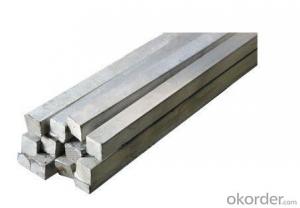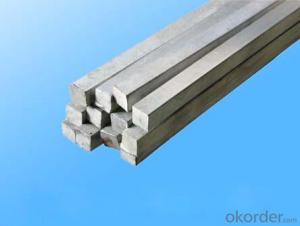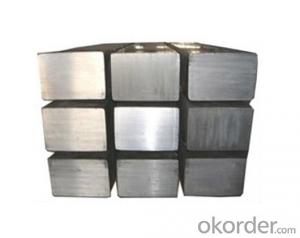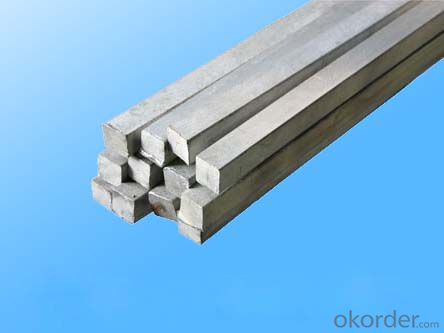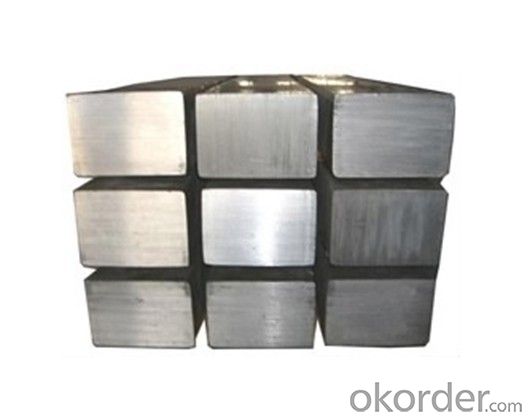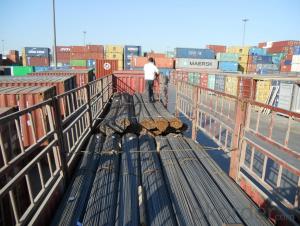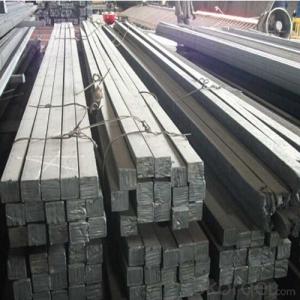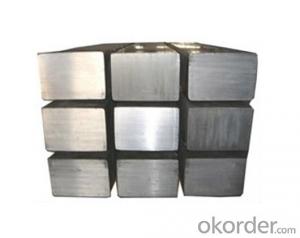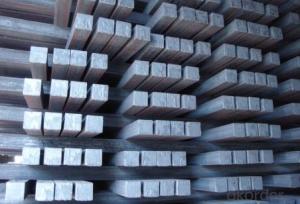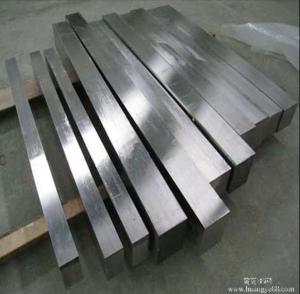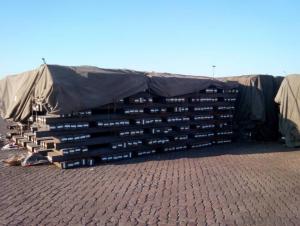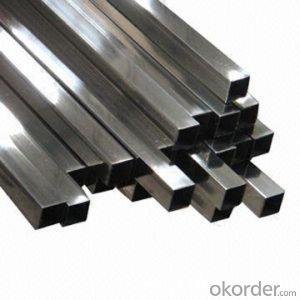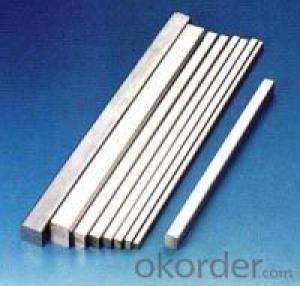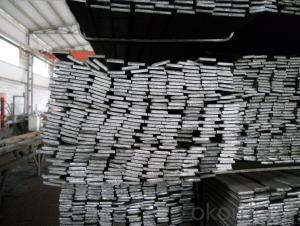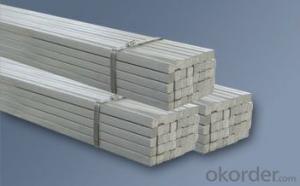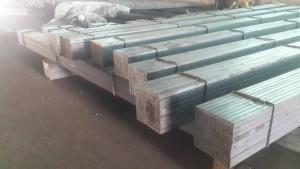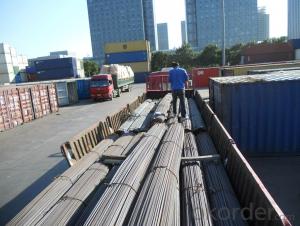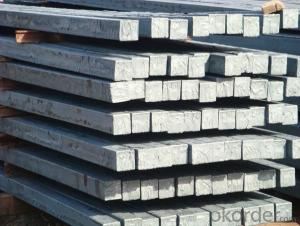Q195Cr High Quality Steel Square Bar
- Loading Port:
- Tianjin
- Payment Terms:
- TT OR LC
- Min Order Qty:
- 1000 m.t.
- Supply Capability:
- 100000 m.t./month
OKorder Service Pledge
OKorder Financial Service
You Might Also Like
Product Description:
Product Description:
In the production of steel products, steel is molded and reshaped with different machinery at different temperatures. One process is steel rolling, which involves metal stock passing through a pair of rolls. Rolling produces flat steel sheets of a specific thickness, and the process is classified according to the temperature at which the metal is rolled. If the temperature of the metal is above its recrystallization temperature, or the temperature at which the grain structure of the metal can be altered, then the process is termed as hot rolling. If the temperature of the metal is below its recrystallization temperature, the process is termed as cold rolling.
Like cold rolling, cold drawing is performed at room temperature, but instead of producing a flat object like a coke can, cold drawing makes steel into the form of a wire like the spokes of a wheel or a paper clip. To start the process, Steel is usual hammered and rolled so that it can be fit through a die; a tool that turns the steel mass into a wire. The room temperature steel is pulled through the die which reshapes it into a thinner shape while maintaining the same volume. It is similar to the idea of syrup flowing out of a bottle through a tube in that it changes shape but not volume, but instead of squeezing the metal, it is pulled out. In order to get the wire down to the right diameter, it usually requires more than one pass through different dies.
Colddrawn steel, steel covered carbon steel, excellent carbon steel, alloy structural steel, carbon tool steel, spring steel, bearing steel, tool steel, cold heading steel, free cutting steel, martensite stainless steel; products include all kinds of shapes round, square steel, hexagonal, flat steel and other conventional products, including various special-shaped steel products. In all types of colddrawn steel industry has been widely used, these areas include automotive, machine tools, furniture, standard parts, textile machinery, agricultural machinery, military industry and other industries.
The total assets of more than 40 million, as of the end of 2010 with fixed assets of 34 million, with 60 tons from 5 tons a chain drawing machine 10 sets, horizontal and inverted coiled wire drawing machine 5 sets, steel and plate production line of blasting, high-power ham stove, various straightening machine and cold rolling mill and other major equipment.
Usage/Applications
-The Square Bar is normally used as structure steel.
-Row material for other structure steel like steel angles, channels, I-beams, H-beams, etc…
Packaging & Delivery
-Packing Detail: The products can be packed in bundles by steel wires.
-Marks: We make tag marks and color marks. The tag marks with white background and red company logo will be tied up to each bundle of the products. The information is usually including basic information of products and company and other information requested by customers. As for color marks, we will paint both ends of bundles to make sure that it w
-Delivery Detail: 30~45 working days after receive buyer’s T.T. or L/C.
ill be more convenient for customers to distinguish them from other products.
- Q: How do you use a steel square to find the center of a circle?
- To use a steel square to find the center of a circle, follow these steps: 1. Place the steel square on a flat surface, ensuring that it is level and perpendicular to the ground. 2. Position the circle whose center you want to find on top of the steel square, making sure that it is also flat and stable. 3. Locate the two sides of the steel square that are perpendicular to each other. These sides are typically labeled as the blade and the tongue. 4. Align the blade of the steel square so that it is tangent to the circumference of the circle at any point. 5. Rotate the circle while keeping the blade in contact with the circumference. As you rotate, you will notice that the tongue of the steel square will intersect the circumference at two points. 6. Mark these two points on the circumference of the circle. 7. Draw a straight line connecting the two marked points on the circumference. 8. Repeat steps 4 to 7 at a different tangent point on the circle. 9. The intersection of the two lines you drew in steps 7 and 8 is the center of the circle. By using a steel square in this manner, you can accurately determine the center of a circle. This technique is particularly useful in woodworking, construction, and other applications where precision is crucial.
- Q: Can a steel square be used for plumbing and pipefitting?
- Certainly! A steel square, which is also referred to as a carpenter's square or a framing square, possesses the versatility required for plumbing and pipefitting tasks. This tool enables the measurement and marking of angles, the assessment of squareness, and the achievement of precise cuts and joints. In the realm of plumbing and pipefitting, a steel square serves the purpose of measuring and aligning pipes, executing meticulous cuts, and ensuring the appropriate angles and squareness in fittings and connections. Additionally, it proves valuable in establishing reference points and facilitating the proper installation of pipes and fixtures. Nevertheless, it is crucial to acknowledge that for more specialized plumbing and pipefitting endeavors, alternate tools specifically tailored for those tasks may prove more suitable and accurate.
- Q: How do you use a steel square for creating accurate lap joints?
- To use a steel square for creating accurate lap joints, follow these steps: 1. Begin by selecting the appropriate size of steel square that matches the dimensions of your lap joint. Steel squares come in various sizes, such as 6 inches, 12 inches, or 24 inches, so choose one that fits your project. 2. Measure the length of the lap joint on the board or material you are working with. Use a tape measure to ensure accurate measurements. 3. Set the steel square on one end of the material, aligning it with the edge. Make sure the square is flush against both the end and the side of the material. 4. Hold the steel square securely in place with one hand while using a pencil or marking tool to trace along the inside edge of the square onto the material. This will create a straight line that represents the width of the lap joint. 5. Repeat the process on the other piece of material that will form the other half of the lap joint. Ensure that both pieces are marked accurately and consistently. 6. Use a saw or other cutting tool to carefully cut along the marked lines on both pieces of material. Take your time to ensure a clean and accurate cut, as this will determine the quality of the lap joint. 7. Once the cuts are made, test fit the two pieces together to check for accuracy. They should fit snugly and create a flush joint when assembled. If adjustments are needed, use a file or sandpaper to remove any excess material until the fit is perfect. 8. Apply an appropriate adhesive or fasteners to secure the lap joint in place, following the instructions provided with the chosen method of joining. By using a steel square as a guide, you can ensure that your lap joints are precise and accurately aligned, resulting in strong and visually appealing finished projects.
- Q: Can a steel square be used for deck railing layout?
- Yes, a steel square can be used for deck railing layout. A steel square is a versatile tool that can be used to measure and mark angles accurately, making it suitable for planning and positioning deck railing components.
- Q: Can a steel square be used for measuring angles in concrete work?
- Yes, a steel square can be used for measuring angles in concrete work. Steel squares are versatile tools that can be used for various applications, including measuring and marking angles. They have a right angle shape, with one side being 90 degrees, which makes them particularly useful for checking the accuracy of corners and angles in concrete work. By placing the steel square against the corner or angle being measured, it can assist in ensuring that the concrete is being laid at the correct angle and in maintaining the integrity of the structure being built. Additionally, steel squares are typically made of durable materials that can withstand the rigors of concrete work, making them a reliable tool for measuring angles in this context.
- Q: Can a steel square be used for checking the squareness of floor tiles?
- Yes, a steel square can be used for checking the squareness of floor tiles. A steel square is a precision measuring tool that has a right angle shape, making it suitable for checking if floor tiles are laid at a perfect 90-degree angle. By placing the steel square against the corners of the tiles, one can easily determine if they are properly aligned and square. The straight edges of the square can also be used to ensure that the tiles are laid in straight lines. However, it is important to note that other tools such as a carpenter's square or a T-square can also be used for this purpose, depending on personal preference and availability.
- Q: Can a steel square be used for checking the levelness of a floor?
- No, a steel square cannot be used for checking the levelness of a floor.
- Q: Can a steel square be used for cabinet making?
- Cabinet making can indeed make use of a steel square. Known by various names such as framing square or carpenter's square, a steel square is a versatile tool widely employed in woodworking. Although not specifically designed for cabinet making, it remains highly effective in carrying out diverse tasks throughout the cabinet making process. Made from durable steel, the steel square consists of two arms, one longer than the other, which intersect at a right angle. Its primary function is to mark and measure angles, ensure squareness, and facilitate precise and accurate cuts. These attributes make it an indispensable tool for cabinet making. When constructing cabinets, the steel square proves invaluable in determining and marking appropriate angles and measurements for cutting and joining cabinet components, such as panels, shelves, and doors. By employing the steel square, the cabinet's squareness and alignment can be guaranteed, resulting in a well-constructed and structurally sound piece of furniture. Furthermore, the steel square is useful in gauging the squareness of corners and joints, thereby guaranteeing perfect 90-degree angles. This aspect is crucial in achieving a professional and seamless finish in cabinet making. Although specialized tools exist for specific cabinet making tasks, the steel square offers versatility and cost-effectiveness, meeting a wide range of measurement and marking requirements. Consequently, it is a staple in the toolboxes of both amateur and professional cabinet makers alike.
- Q: Can a steel square be used for checking the levelness of a table saw top?
- Using a steel square is not suitable for verifying the levelness of a table saw top. Although a steel square is valuable for measuring right angles and assessing the squareness of a surface, its design does not allow for determining the levelness of a table saw top. To accurately check the levelness of a table saw top, it is necessary to employ a precision level or a straight edge. These tools are specifically created for this purpose and deliver precise readings, guaranteeing that the table saw top is completely level. This is crucial in order to achieve meticulous and accurate cuts.
- Q: What are the common mistakes to avoid when using a steel square?
- To ensure accurate measurements and precise angles when using a steel square, it is important to avoid several common mistakes: 1. Avoid misalignment by ensuring that the steel square is perfectly parallel to the edges or surfaces being measured. Any misalignment can result in inaccurate measurements and flawed angles. 2. Maintain a steady and consistent pressure while marking or cutting to avoid variations in the measurements. Inconsistent pressure can lead to inaccuracies. 3. Regularly check the squareness of the steel square and make necessary adjustments or replacements. Ignoring squareness can result in skewed measurements and inaccurate angles. 4. Position the steel square firmly against the edges or surfaces being measured to obtain accurate readings. Placing it in the wrong position can lead to errors and imprecise measurements. 5. Regularly clean the steel square to prevent accumulated dirt, dust, or debris from interfering with accurate measurements. Cleanliness ensures smooth movements and precise readings. By avoiding these common mistakes, users can effectively utilize a steel square for measuring, marking, and cutting tasks, guaranteeing precise angles and accurate measurements.
Send your message to us
Q195Cr High Quality Steel Square Bar
- Loading Port:
- Tianjin
- Payment Terms:
- TT OR LC
- Min Order Qty:
- 1000 m.t.
- Supply Capability:
- 100000 m.t./month
OKorder Service Pledge
OKorder Financial Service
Similar products
Hot products
Hot Searches
Related keywords
